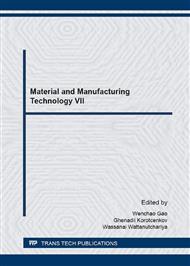p.3
p.8
p.13
p.18
p.23
p.28
p.33
p.38
Effect of Alloying Elements on the Hardness Property of 90% Copper-10% Nickel Alloy
Abstract:
The objective of this study is to investigate the effect of adding some alloying elements (including iron, aluminum, chromium, cobalt, and titanium) to 90 wt. % copper – 10 wt. % nickel alloy on the hardness property. Copper-nickel synthetic alloys were prepared in an induction furnace, in an argon/7% vol. hydrogen atmosphere in cylindrical boron nitride crucibles. They were then homogenized at 950°C for 10 hours in the same protective atmosphere. Vickers hardness measurements, microstructure examination, and Energy Dispersive Spectrometry (EDS) mapping analysis were performed for all synthetic alloys. Hardness measurements results show that the addition of all the alloying elements used in this investigation improve the hardness of the 90 wt. % copper – 10 wt. % nickel alloy. It was concluded that the aluminum was the most effective alloying element on the hardness value for 90 wt. % copper – 10 wt.% nickel alloy.
Info:
Periodical:
Pages:
13-17
Citation:
Online since:
September 2016
Authors:
Price:
Сopyright:
© 2016 Trans Tech Publications Ltd. All Rights Reserved
Share:
Citation:


